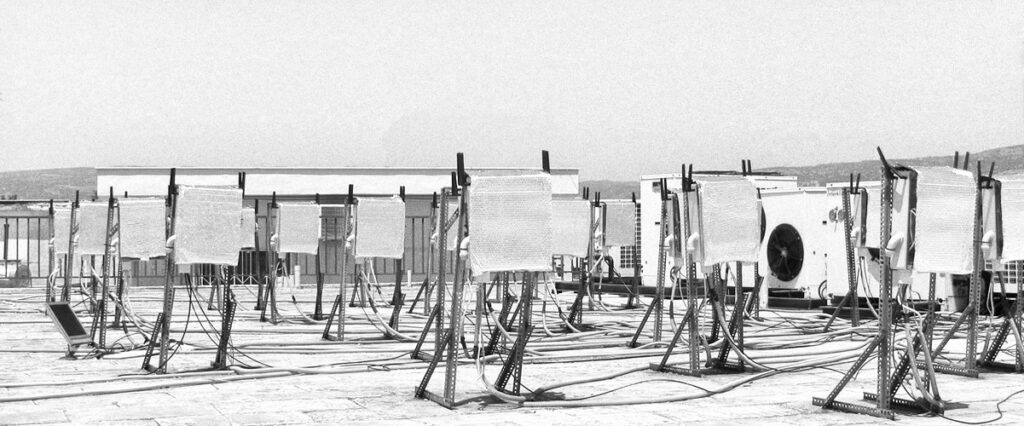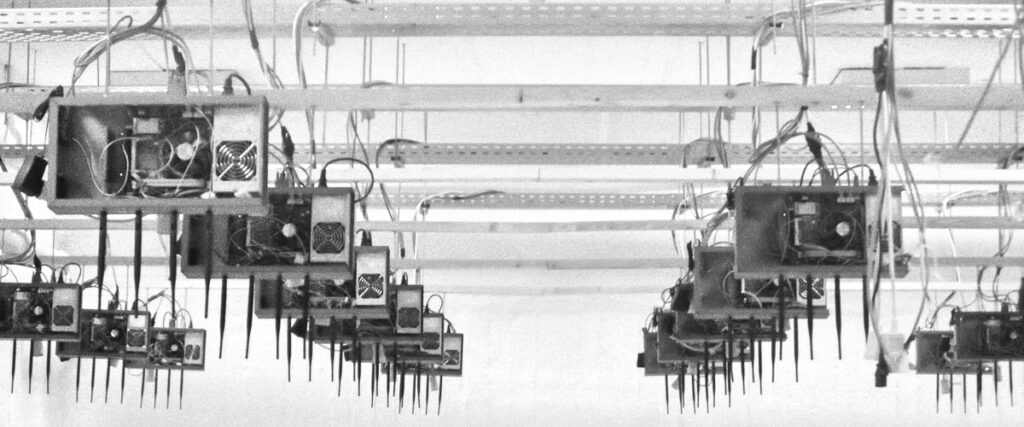nitos
NITlab Director Professor Thanasis Korakis and its members welcome you to our website.
NITOS Future Internet Facility is a state-of-the-art, integrated research infrastructure comprising multiple heterogeneous testbeds. It is dedicated to supporting experimentation-driven research in the field of wired and wireless communication networks. The facility is remotely accessible and available to the global research community 24/7. To date, it has been utilized by hundreds of researchers worldwide.
NITOS is composed of three distinct testbed deployments:
Outdoor Testbed

NITOS outdoor offers a large-scale environment for experimenting with wireless technologies in open-air conditions. With a dense deployment of multi-interface nodes mounted across building exteriors, it supports advanced experimentation in Wi-Fi and other wireless protocols. This setup enables real-world validation of mobility, interference, and coverage scenarios in a dynamic outdoor setting.
Indoor RF Isolated Testbed

Designed for precision and control, the indoor testbed operates within a radio-frequency shielded environment, allowing researchers to conduct reproducible wireless experiments without external signal interference. It features a dedicated set of programmable nodes equipped with multiple radio technologies, as well as directional antennas for spatial and beamforming studies.
Office Testbed

This testbed simulates everyday wireless deployments in an indoor office setting. It consists of compact, multi-interface nodes strategically placed in real workspaces to support realistic experimentation. Ideal for testing protocols and applications in environments with walls, furniture, and human activity, it bridges the gap between lab conditions and real-world performance.
Explore NITOS Research Facility
NITOS brings together a diverse range of advanced infrastructures designed to support cutting-edge research and innovation in telecommunications, programmable networking, (edge) computing, and wireless technologies. It offers a comprehensive, open, and remotely accessible platform for experimentation, enabling both fundamental research and applied system validation.
Wireless Experimentation Platform
NITOS provides a highly versatile wireless networking testbed, enabling researchers to conduct real-world experiments across a spectrum of radio technologies and deployment scenarios. The platform features a mix of stationary and mobile nodes, each equipped with multiple wireless interfaces that support technologies such as 5G, Wi-Fi, WiGig, and others. These nodes are deployed across diverse environments, from controlled indoor labs with external RF isolation to complex outdoor spaces where interference and mobility reflect real-world conditions.
This configuration allows experimentation at multiple layers of the protocol stack—from physical layer customization to application-layer performance testing—facilitating research in multi-radio access technologies (multi-RAT), spectrum sharing, and next-generation wireless systems. The testbed supports repeatable trials, multi-hop mesh setups, mobility patterns, and heterogeneous interface coexistence, making it ideal for both academic and industrial research.
Cloud and Edge Computing Resources
To support distributed systems and networked applications, the NITOS facility includes a powerful computing cluster composed of multi-core, high-memory servers with substantial storage capacity and high-throughput network interconnects. This infrastructure enables experimentation with a wide range of cloud and edge computing paradigms.
The platform supports virtualization (VMs), container orchestration (e.g., Kubernetes, Docker), and bare-metal deployment, allowing researchers to explore topics such as microservice-based architectures, resource offloading, network slicing, NFV, and service chaining. Fast internal and external connectivity facilitates integration with other testbed components—such as wireless or IoT infrastructures—enabling end-to-end experimentation across heterogeneous layers.
Urban and Mobile Sensor Networks
NITOS supports real-world sensing applications through a combination of fixed and mobile sensor deployments. The infrastructure spans controlled indoor setups, outdoor urban environments, and dynamic mobile platforms such as bicycles or portable kits. This hybrid configuration allows researchers to study sensing, data aggregation, mobility, and distributed intelligence in realistic settings.
Sensor nodes are built using open hardware platforms that support technologies like ZigBee, LoRa/LoRaWAN, Wi-Fi, and 5G. They can be reprogrammed and extended with new sensing modalities and protocols. This testbed is particularly well-suited for research in environmental monitoring, participatory sensing, smart cities, and low-power wide-area networking (LPWAN). It enables scalable experimentation with time-series data, energy-efficient communication, and edge analytics under real-world conditions.
Software-Defined Radio (SDR) Capabilities
For researchers interested in custom wireless protocol development and physical layer innovation, NITOS offers access to a rich set of high-end software-defined radio platforms. These SDR devices are fully integrated with the testbed’s compute and wireless infrastructure, enabling both isolated lab-scale experiments and over-the-air trials.
The available SDRs support advanced configurations such as 4×4 MIMO, channel bandwidths of up to 100 MHz, and high-frequency tunability. Combined with flexible software stacks (e.g., GNU Radio, srsRAN, OpenAirInterface), they allow full-stack experimentation, from waveform generation and channel modeling to real-time signal processing and PHY/MAC protocol design. The SDR testbed also supports research in spectrum sensing, dynamic access control, and cross-layer optimization.
Programmable Networking (SDN)
The NITOS infrastructure is equipped with a fully programmable networking environment that supports software-defined networking across both wired and wireless domains. Utilizing SDN-capable switches and programmable forwarding engines, researchers can design and deploy custom network control policies, routing strategies, and traffic engineering solutions.
The testbed supports OpenFlow and advanced data plane programmability via the P4 language, enabling low-level control over packet processing pipelines. This allows for experimentation with novel network functions, telemetry, intent-based networking, and integration with edge computing and IoT environments. The SDN infrastructure is ideal for exploring topics such as network slicing, service function chaining, and security-aware routing in programmable, multi-domain environments.
Open and Remote Experimentation
NITOS is designed with openness, accessibility, and reproducibility at its core. The entire facility operates on open-source platforms and is fully accessible remotely through a user-friendly web interface. Researchers can configure nodes, schedule and launch experiments, access live telemetry, and retrieve results—all from anywhere in the world.
This remote experimentation model enables global collaboration, supports cross-institutional research projects, and ensures repeatability and traceability of experiments. Integration with control and management frameworks and experiment description languages makes the process both powerful and intuitive. Whether you’re testing a new wireless protocol or deploying a distributed edge application, NITOS offers the tools and flexibility to bring your research to life.
